Commemorating O. Richard Norton (1937-2009)
Tuesday evening late, I received an email from Dorothy Norton, and as I
started to read it my reaction was identical to Zelimir's: “An
undefined forewarning immediately crossed my mind ... Oh my God, NO! ...
not Richard ... not HIM"!
But yes, it was him; Richard had passed away, after a long illness.
He is gone but he has not really left us and never will, as long as we
have his books. As Kathie McConnel put it: “I never got to meet
Richard in person but I felt as if we were friends through his books. I
relied on his experiences, knowledge, passion, and expertise to educate
me about meteorites. Many nights that I read from his books we had
conversations in my head and heart. I felt that he was there talking to
me and I could see his smile”.
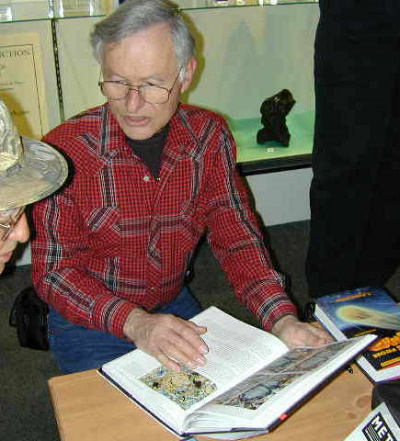
Tucson, 2002
Photo: Anne Black
As great as his books
were, Richard was much more than that. In 1997, he introduced himself to
Andrzej Pilski this way:
“You asked me about my experience in the planetarium. I have been
director of two planetariums, both in university environments. I
received practical training at the Griffith Observatory and Planetarium
in Los Angeles while I was an astronomy student at the University of
California. I liked the planetarium environment so much that I decided
to make it a career. My first directorship was at the Fleishmann
Planetarium at the University of Nevada in Reno. I opened the
planetarium and worked there for 10 years. While there I designed a 35
mm motion picture projection system to project film over the entire dome
area. We called it the Atmospherium since it was first used to produce
time lapse motion pictures of weather phenomena in the planetarium. I
filmed the Apollo 10, 11, 12, 14, and 17 liftoffs to the moon from 1969
to 1972. Our cameras were on the launch pad only 800 feet from the base
of the Saturn 5 rocket. Many of these experiences are related in a book
I wrote in 1969, The Planetarium and Atmospherium: An Indoor Universe.
I was a consultant for the Minolta Camera Company and worked to design
their line of planetarium projectors. I worked with their engineers for
six years and helped to install five of their projectors around the
United States.
I left the University of Nevada to take a position at the University of
Arizona in Tucson in 1973, an important research center for Astronomy. I
designed a multimillion dollar planetarium and science museum complex on
the campus. It is called the Flandrau Planetarium and Science Center. I
worked with optical scientists on the campus to design and build a
fisheye projection system for a 50 foot dome. In 1984, our cameras flew
aboard the Challenger Space Shuttle and made the first 180° motion
picture film in space. Today there are at least six of these systems in
various planetaria around the United States. I left the University of
Arizona after 14 years and moved to Bend, Oregon where I now teach
astronomy in a small college and write articles and books and study
meteorites. I also formed a company called Science Graphics that
designs and manufactures science teaching slides in astronomy, planetary
science, geology and paleontology. These slides are currently being used
in about 3,000 colleges and universities in the United States and
abroad.
That is briefly what I have been doing for the last 30 years.
O. Richard Norton
PS. I thought you would like a small meteorite for your growing
collection, a gift from a fellow planetarian. It is a IIIA medium
octahedrite iron from Henbury craters in Australia."
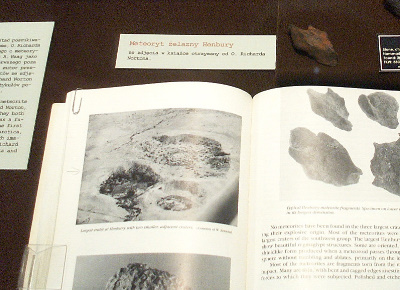
Richard's Henbury and
book, displayed in the Meteorite Exhibit,
Muzeum Mikolaja Kopernicus, Frombork, Poland
Photo: Andrzej S. Pilski
Richard was not only a
book-man, he loved to go out and hunt for his own meteorites. And he
found his own Gold Basin, as Jack Schrader reminded us:
”I first met Richard 'Doc' Norton on a very cold but sunny morning in
Gold Basin. I think the year was 1997. Twink and Jim were there as well
as John Blennert and my son Devin and we were all standing around
shivering in the cold morning air talking and shifting around trying to
catch the first early rays of sunshine and a little warmth when the back
of a station wagon with Oregon plates popped open and Richard slowly
emerged from his sleeping bag like a bear coming out of hibernation.
Hands in his coat pockets, he had a huge smile on his face and he could
not have been happier that morning than to have a full day of nothing
else to do before him but hunt for meteorites. He was full of enthusiasm
and optimistic that he 'was going to find a meteorite' that very day.
His enthusiasm was contagious and he never uttered a discouraging word
and kept the rest of us going and excited. I am proud to say that I
hunted meteorites with Richard that day and I was there when he found
his 175 gram Gold Basin stone.”
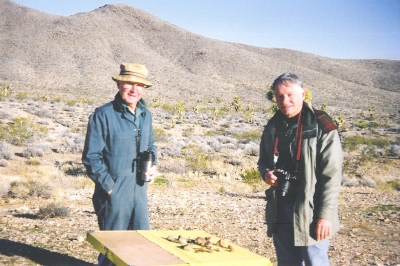
Jim Kriegh and
Richard Norton in Gold Basin, April 1998
Photo: Twink Monrad
As long as his health
permitted, Richard was a permanent fixture in the Tucson show. He was
always ready to look at new meteorites, and answered all questions from
newcomers and experts, collectors and dealers. He also did some shopping
for his own collection, and bought some thin-sections from Steve Arnold:
”A memory that pops into my mind just now is of a meeting with
Richard and Dorothy over lunch in Tucson, one year. Richard wanted to
see what I had in the way of thin sections when I pulled out 6 Kapoeta
thin sections I had from the King Collection. He was beside himself as
he was on a budget and yet he wanted to buy more than just one of them.
He held one of them up and referring to the specimen being a Howardite,
and said almost in amazement 'This one slide holds a complete rock
collection on it!' As I recall, he settled on buying 3 of the them.
Normally I leave after making a sale to someone glad that I made some
money. But I left that day with the pride swelling in my heart that I
could bring something special to Richard, with all his experience and
expertise, that he genuinely appreciated. His smile beaming out from
under his eye loupe, while examinating a new meteorite someone just
handed to him (whether at Jim and Twink's party, or in the corner at one
of Blood's Auctions, or at one of the many dealer's rooms in Tucson)
will be the image I will forever hold in my mind of him.”

Tucson 2002
Photo: Anne Black
During the Tucson Show of 2003, Geoff Notkin and Steve Arnold bestowed the Harvey Award on Richard and Dorothy for their many accomplishments.
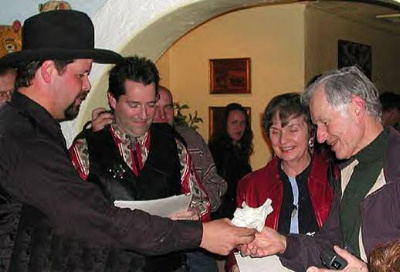
Tucson 2003 – Harvey Awards
But
everything must come to an end in our World, books and lives are no
exception. Sometimes that end comes abruptly and when least expected.
Twink reminded us of that fact when she quoted Richard's own words in
the Epilogue of ”Rocks from Space”:
”In late 1984, I gave a small iron meteorite to astronaut Dick Scobee
in commemoration of his visit to the University of Arizona, where he had
graduated in engineering. Scobee was scheduled to command the space
shuttle early the next year. I suggested, half in jest, that he return
the meteorite to its home in space on his next voyage. In a way, it
would be a historic event - a meteorite returning to space! A few weeks
later a letter arrived from Scobee. He thanked me for the meteorite,
calling it a "nice little treasure" and assured me that he would,
indeed, return it "at least temporarily to the environment from which it
came." On January 28, 1986, the meteorite began its historic return
journey but never made it home. Nor did the crew of seven. Their ship
was the Challenger.”
Yesterday I received the following message from Dorothy:
”I just learned today that the Field Guide has received an award - or
will receive, in October. From the Geoscience Information Society, the
Mary B Ansari Best Reference Work Award. They want someone to accept it
at a banquet in Portland, O. Richard and Larry would have been so
pleased. So sad that we didn't learn about it earlier.”
Wherever he is now, I am sure Richard is smiling.
Yes, Richard you can smile and be proud of your accomplishments and of a
life well-lived.
Anne M. Black
Vice-President of IMCA Inc.
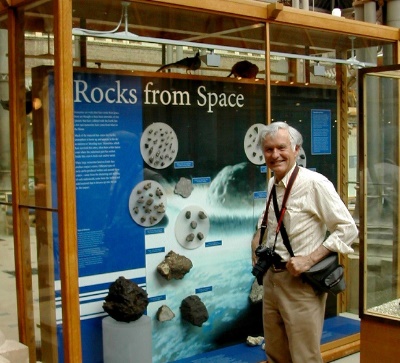
Natural History
Museum, Oxford – 2004
Photo: Dorothy Norton
•
IMCA Home Page •
IMCA Code of Ethics •
IMCA Member List
•
Join IMCA •
IMCA Meteorite Info